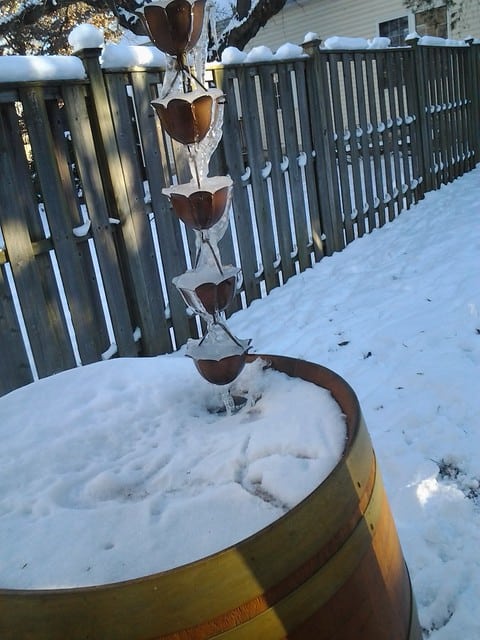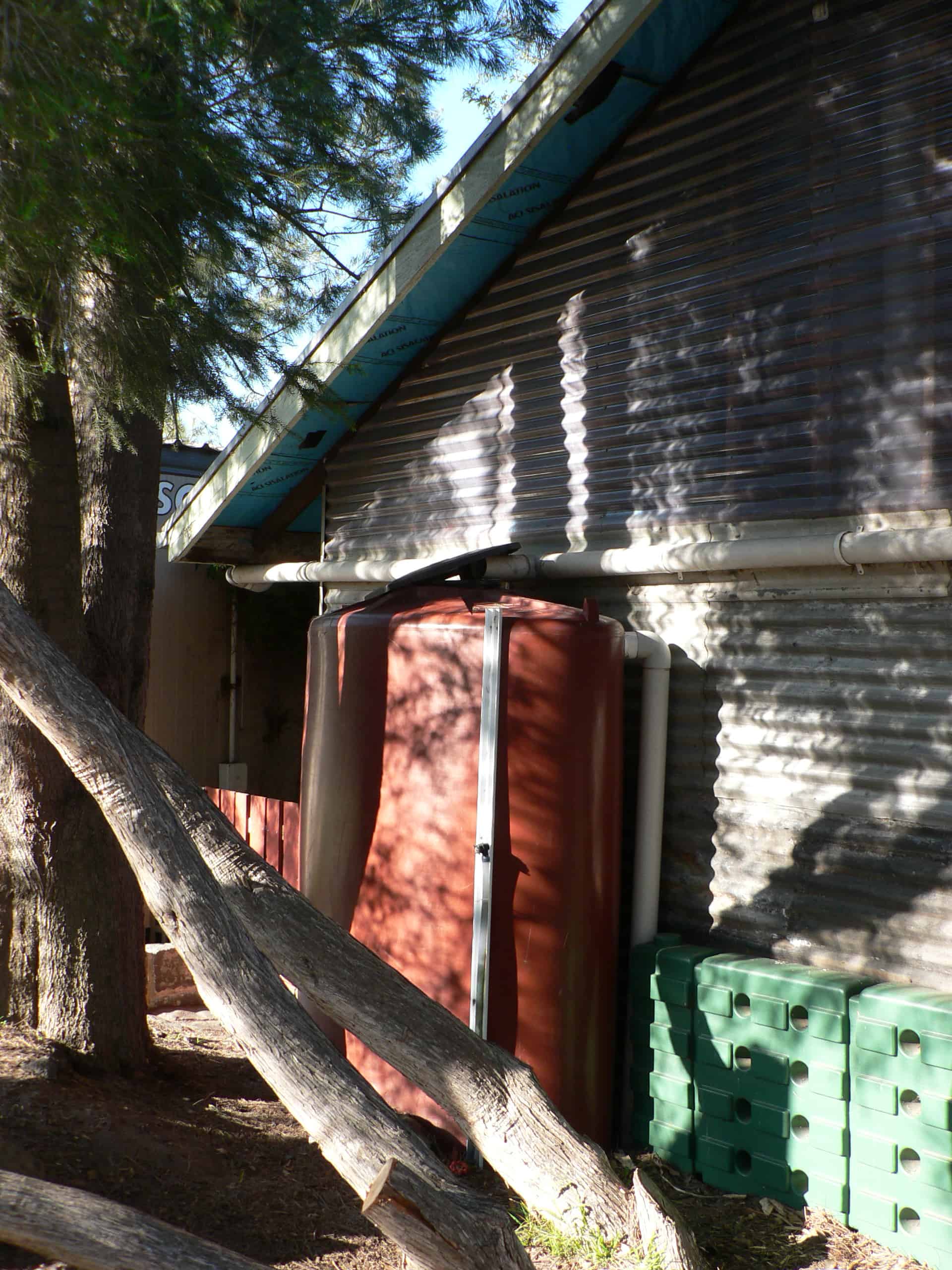As the days get shorter and the nights start getting cold, responsible rain barrel owners know that it’s time to do the yearly maintenance. But if you’re new to the rain barrel life or haven’t given it much thought before, you might be wondering why? Well, it’s important to winterize your rain barrel so that you do not risk it suffering (sometimes irreparable) damage. Keep reading, and let’s explore how to keep your rain barrel healthy for many more winters to come.
Psst
We wrote an entire rain barrel buying guide for 2020. If you’re in the market, consider giving it a read!
When You Should Winterize
If you live in an area that experiences harsh, freezing temperatures in the middle of winter, you should winterize before the first frost. If you live in a mild winter climate, or even one that experiences only intermittent freezing, you may not have to winterize at all. The best thing to do is to find out the standards for outdoor plumbing in your area and follow suit. Depending on the climate, you have one of two options available.
- In a colder climate, you need to store your barrel for the winter.
- In a warmer climate, you can probably leave your barrel outside, as long as you remove the spigot and plug the hole.
Since the warmer climate has things so easy, we’re going to focus on the cold climate.
Winterizing In A Cold Climate

Completely Drain Your Rain Barrel
To winterize your rain barrel, you first need to be sure to drain the water out of your barrel before it freezes. When water freezes, the water molecules actually expand, and this can cause major damage to your rain barrel, including cracking. You must drain your rain barrel before the first freeze of the season to avoid any damage happening. Once all of the water is drained, make sure that you leave the spigot open so that any water that enters the barrel can drain before it has a chance to freeze.
Detach Your Rain Barrel From The Downspout
The next step is to detach your rain barrel from the downspout. You need to reconnect the downspout to send water away from the foundation of your house. While you are already working near and around the gutters, you should also clean them to make sure that they are free of leaves and other debris for the winter.
Remove Any Hoses/Spigots From Your Rain Barrel
Now you will want to remove the hoses and spigots and put them away for the winter. Hoses are susceptible to freezing and being damaged if any water is left inside, so make sure that you fully empty them before you coil them up and put them away. You should also remove and clean any mesh parts to your rain barrel and store them for the winter.
Thoroughly Rinse Your Rain Barrel
Now is a good time to rinse and clean out your rain barrel. Odds are that leaves and debris made their way into the barrel over the summer, and it is a good idea to clean it before you put it away for the winter.
Store Your Rain Barrel In A Clean, Dry Place
You can move the rain barrel inside, or put it on your porch, in the basement, or in the garage for the winter. It is also possible to turn it upside down so that no water can enter it and leave it out in a spot that receives a lot of sunlight. However, the better option is to bring it indoors.
Additional Maintenance
Besides the need to winterize your rain barrel, you need to perform maintenance from time to time. The important things are to remember to remove leaves and other debris regularly and drain the water before any big storm. If you don’t drain it, there won’t be room for the water once the storm arrives.
You should check the rain barrel to make sure that it is working, and make sure that you use the water as it collects. If you place screens or gutter guards on it, it will help to keep the leaves and other debris out, which will make the water easier to use.
The following are tips that you can use as you need to.
- Cleaning: When you need to clean your rain barrel, make sure that you use a nontoxic cleaner. Otherwise, the water will be contaminated and unable to be used to water your plants and trees.
- Travel Prep: If you are going to be away, you should open the barrel spigot and make sure that it drains away from the foundation of your home.
- Winterize: You need to disconnect the rain barrel and winterize it during the winter.
- Mosquitoes: Clean out gutters and downspouts to deter mosquitoes, and if you have them in your rain barrel, use a product such as Mosquito Dunk to eliminate them.
Things To Avoid
Here are some cautions as to what you should avoid both to protect your rain barrel and to ensure the safety of those who are around it. Do not:
- Leave standing water for long periods of time
- Use as drinking water for humans or animals
- Let the rain barrel tilt or become unstable
- Let children play on or near the rain barrel
- Forget to reconnect it after the winter
Dealing With A Cracked Rain Barrel
If you don’t get your rain barrel winterized in time and the water inside freezes, there is a strong likelihood that it will crack. Water molecules expand when they freeze, and they won’t have room to expand, which is why they cause the rain barrel to crack.
You can try to have the damage repaired, and if the crack is minor, it may be possible. Follow these steps to repair a crack in your rain barrel:
- Sand the crack until the entire cracked area is even and smooth.
- Drill a small hole at each end of the crack.
- Wipe the area clean and dry.
- Cut a piece of fabric bigger than the crack.
- Apply a thick bead of silicone caulk along the crack.
- Put the fabric over the caulked area. Press until fabric is flush with the plastic.
- Caulk along the crack inside the barrel.
Depending on how severe your crack is, this may work to repair it. The best way to avoid this kind of damage is by making sure that you winterize your rain barrel before the first frost occurs each year.
Final Thoughts
A rain barrel is very useful and environmentally friendly. It can save money on your utilities by providing a water source for watering your plants and trees or washing your car. In addition, it protects your home by preventing water from building up near the foundation. You do need to make sure that rain barrels are allowed in your location before you install one, as they are not permitted in some areas and require a permit in others.
It is not difficult to winterize your rain barrel, and it is important that you take the time to do so before the first frost of the winter. Never try to move the rain barrel with water inside, as it will be too heavy, and you could hurt yourself or the rain barrel. You can avoid this situation by making sure that you use the rainwater within a week or two of it accumulating in the rain barrel.
If you find that you are collecting more rain than you can use, you can attach a hose and allow it to slowly drain away from your home. This is a better idea than leaving the rainwater in the barrel for extended periods of time.

